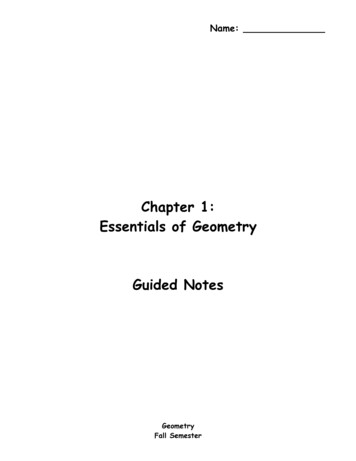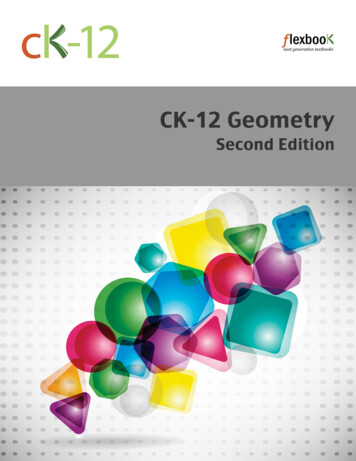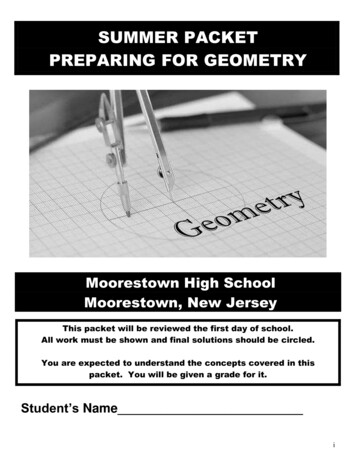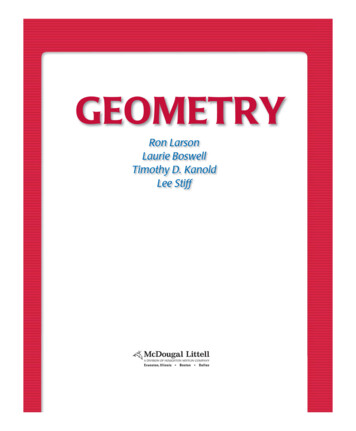
Transcription
Name:Chapter 1:Essentials of GeometryGuided NotesGeometryFall Semester
CH. 1 Guided Notes, page 21.1 Identify Points, Lines, and PlanesTermundefined termspointlineplanecollinear pointscoplanar pointsdefined termsline segment(segment)endpointsDefinitionExample
CH. 1 Guided Notes, page 3rayopposite raysintersectionNaming and symbols:Point:Line:Plane:Line Segment:Ray:Examples:1.Other names for LN :Other names for plane Z:Points that are collinear:
CH. 1 Guided Notes, page 42.Another name for VX :All rays with endpoint W:Opposite Rays:3. Sketches:a) Sketch a plane and a line that intersects the plane at one point.b) Sketch a plane and a line that is in the plane. Sketch another line that intersects the line andplane at a point (use dotted lines to show where the intersecting line can not be seen).c) Sketch two planes that intersect in a line.Step 1: Draw one plane as if you are facing it. (straight up and down)Step 2: Draw a second plane that is horizontal. (Use dotted lines to show where oneplane can not be seen).Step 3: Draw the line of intersection.
CH. 1 Guided Notes, page 51.2 Use Segments and dinatedistanceThe points on a line can be matched one-toone with the real numbers.Ruler PostulatebetweenIf B is between A and C, thenSegmentAB BC AC. If AB BC AC, then B isAdditionbetween A and C.PostulatecongruentsegmentsExample
CH. 1 Guided Notes, page 6Examples:1. Measure the length of CD to the nearest tenth of a centimeter using a ruler andthe ruler postulate.2. Use the Segment Addition Postulate to write an equation and solve for KL.3. Plot F(4,5), G(-1,5), H(3,3), and J(3,-2) on coordinate grid. Then determine whether FG and HJ arecongruent.
CH. 1 Guided Notes, page 71.3 Use Midpoint and Distance FormulasTermDefinitionmidpointsegment bisectorThe coordinates of the midpoint of aThe MidpointFormulasegment with endpoints (x1,y 1) and (x2,y 2)x x 2 y1 y 2are & 1, 22%#.!!"The distance d between any two points withThe Distancecoordinates (x1,y 1) and (x2,y2) is given byFormulad (x2 ! x1 )2 (y 2 ! y1 )2 .In a right triangle, the sum of the squaresof the measures of the legs equals thePythagoreansquare of the measure of the hypotenuse.Theoremleg2 leg2 hyp2a2 b 2 c2Example
CH. 1 Guided Notes, page 8Examples (Part One):1.2.Find the length of3.BD.
CH. 1 Guided Notes, page 9Line l bisects the segment. Find the indicated length.4.Find DF if DE 17cm.D5.lEFFind GJ if HJ 8 ¼ in.GlHJ
CH. 1 Guided Notes, page 106. What is the approximate length of RT , with endpoints R(3,2) and T(-4,3)?(Use the distance formula)Now use the Pythagorean Theorem to find the length of RT .7. Find the approximate length of the segment.(Use the distance formula)Now use the Pythagorean Theorem to find the length of the segment.
CH. 1 Guided Notes, page 111.4Measure and Classify Consider!! !! OB and a point A on one side of!! OB . The rays of the form OA can beProtractorPostulatematched one-to-one with the real numbersfrom 0 to 180. The measure of!AOB is equalto the absolute value of the differencebetween the real numbers for!! !! OA and OB .Classifying Angles: Angles are classified by their angle measures.acuterightobtusestraight
CH. 1 Guided Notes, page 12interiorIf P is in the interior ofAngle Additionm!RST m!RSP m!PST .Postulatecongruent anglesangle bisectorconstructionExamples1. Name the three angles in the diagram.2.!RST , then
CH. 1 Guided Notes, page 133.Given that m!GFJ 155 , find m!GFH and m!HFJ .4. Identify all pairs of congruent angles in the diagram.5. In the diagram at the right, WY bisects !XWZ , and m!XWY 29 . Find m!XWZ .
CH. 1 Guided Notes, page 141.5 Describe Angle Pair lessupplementaryanglesadjacent anglesnon-adjacentangleslinear pairvertical anglesExamples:1. In the figure name a pair of complementary angles, a pair of supplementary angles, anda pair of adjacent angles.
CH. 1 Guided Notes, page 152. a) Given that !1 is a complement of !2 and m!2 57 , find m!1 .b). Given that !3 is a supplement of !4 and , m!4 41 , find m!3.3. The basketball pole at right forms a pair of supplementary angles with theground. Find m!BCA and m!DCA .right.4. Identify all of the linear pairs and all of the vertical angles in the figure at the
CH. 1 Guided Notes, page 165. Two angles form a linear pair. The measure of one angle is 4 times the measure of theother. Find the measure of each angle.x Interpreting a DiagramThere are some things you can conclude from a diagram, and some you cannot. Below, wewill list things we can conclude from the diagram at right, and things we cannot conclude.We CAN conclude that:We CANNOT conclude that:
CH. 1 Guided Notes, page 171.6 Classify PolygonsTermplane ralequiangularregularDefinitionExample
CH. 1 Guided Notes, page 18Examples:1. Tell whether the figure is a polygon and whether it is convex orconcave.a).b).c).2. Classify the polygon by the number of sides. Tell whether the polygonis equilateral, equiangular, or regular.3. The head of a bolt is shaped like a regular hexagon. The expressionsshown represent side lengths of the hexagonal bolt. Find the length of aside.
CH. 1 Guided Notes, page 191.7 Find Perimeter, Circumference, and adiameterradiusThe ratio of a circle’s circumference to itsPi ( ! )diameter.Formulas for Perimeter, Circumference, and ferenceAreaP 4sP 2(l w) 2l 2wP s1 s2 s3A s2A l·wA ½bhC !d 2 !rA !r2
CH. 1 Guided Notes, page 20Examples:1. The in-bounds portion of a singles tennis court is shown. Find itsperimeter and area.PerimeterArea2.The smallest circle on an Olympic archery target is 12 centimeters indiameter. Find the approximate circumference and area of the smallestcircle.3. Triangle JKL has vertices J(1,6), K(6,6), and L(3,2). Find the approximateperimeter of triangle JKL.
CH. 1 Guided Notes, page 214. The base of a triangle is 24 feet. The area is 216 square feet. Find theheight of the triangle.5. You are using a roller to smooth a lawn. You can roll about 125 squareyards in one minute. About how many minutes would it take you to roll a lawnthat is 120 feet long and 75 feet wide?
Essentials of Geometry Guided Notes . CH. 1 Guided Notes, page 2 1.1 Identify Points, Lines, and Planes Term Definition Example undefined terms point line plane . 3. Triangle JKL has vertices J(1,6), K(6,6), and L(3,2). Find the approximate perimeter of triangle JKL. CH. 1 Guided Notes, page 21 4. The base of a triangle is 24 feet. The area .










